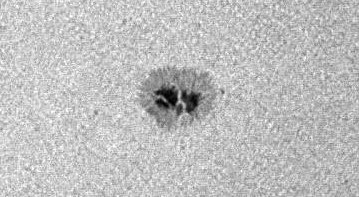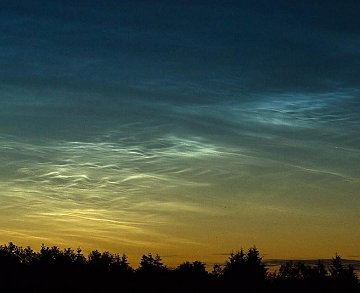 Where's Saturn? Is that a UFO--or the ISS? What's the name of that star? Get the answers from mySKY--a fun new astronomy helper from Meade. Where's Saturn? Is that a UFO--or the ISS? What's the name of that star? Get the answers from mySKY--a fun new astronomy helper from Meade. MARS ROVERS LOSING POWER: A major dust storm on Mars is dimming the sun and reducing sunlight to the solar panels of Spirit and Opportunity. In the past week Opportunity's energy levels dropped sharply from 765 watt-hours to 402 watt-hours, delaying the rover's planned descent into Victoria Crater. The storm is big enough to see in backyard telescopes; amateur astronomers are encouraged to monitor developments. [sky map] FRACTURING SUNSPOT: Sunspot 961 is breaking apart. Pavol Rapavy of Rimavska Sobota, Slovakia, took this picture of the fracturing spot on July 3rd: 
UPDATE: Click to view a three-day animation
The spot's dark core is about as wide as Earth, so we are witnessing the breakup of something as big as a planet. The next 24 hours could prove eventful; solar astronomers, ready your telescopes. more images: from Michael Borman of Evansville, Indiana; from John C McConnell of Maghaberry Northern Ireland; from C. LaCroix, B. Smith, R. Espanoza, S. Hatfield, B. Morrissette and J. Stetson of South Portland, Maine; from Maxim Usatov of Dniepropetrovsk, Ukraine; from Robert Arnold on the Isle of Skye, Scotland; NOCTILUCENT CLOUDS: A glowing bank of noctilucent clouds (NLCs) rolled over Port Angeles, Washington, on July 3rd. "These are the first noctilicent clouds we've seen," says Rick Klawitter who took this picture: 
Photo details: Nikon D200, 30 second exposure at ISO 200, f8, 150mm.
"We noticed the clouds about 90 minutes after sunset--around 10:30 pm," he says. "By 11:15 pm they were gone." This display may signal the onset of regular sightings over the continental United States. NLCs are a summer phenomenon, and as summer progresses, the clouds descend from polar to middle latitudes. Now they've reached Washington, where will they go next? There's only one way to find out: Observers, check the western sky one to two hours after sunset. If you see silvery-blue tendrils spreading up from the horizon, you've probably spotted a noctilucent cloud. 2007 Noctilucent Cloud Gallery
["Noctilucent Cloud"--the song] [Night-Sky Cameras] | 
